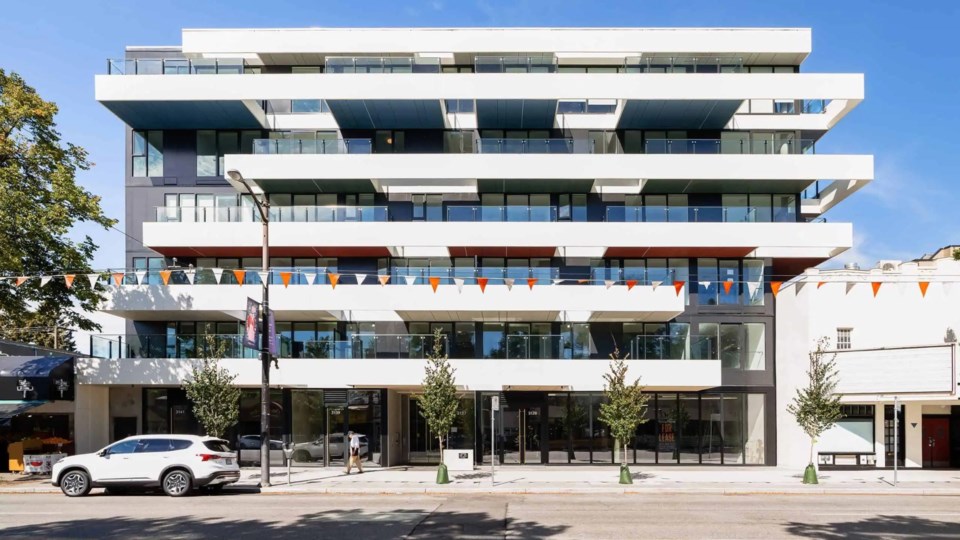Multi-family brokers see signs of increasing activity following a lacklustre first half, with sales down markedly versus a year ago.
Metro Vancouver sales declined by more than 40 per cent in the first six months of 2025 versus a year earlier, according to data from Goodman Commercial Inc.
Transactions were down 46 per cent to 32 deals, while total value fell 40 per cent to $537.3 million.
“The biggest storyline is the massive drop off in the suburbs which saw the lowest number of transactions in over 20 years; even during the height of the COVID pandemic and 2008 global financial crisis there were more than twice as many sales in the suburbs,” said Ian Brackett of Goodman Commercial.
Suburban sales in the period numbered just six, down 81 per cent from a year ago, with an aggregate value of $128.4 million, down 72 per cent from a year ago.
By contrast, Vancouver saw 26 transactions (down two from a year ago) worth a total of $408.9 million, down just five per cent from a year ago.
The divergence is partly explained by the virtual absence from the market of non-profits, which drove much of the activity last year thanks to funding from the province’s $500 million Rental Protection Fund, launched in 2023.
“The market has come back to reality a bit,” Brackett said. “Non-profit and government buyers did 14 deals in the first half of 2024, which dropped off to only four deals in the second half of last year and three transactions in the first six months of 2025.”
Moreover, 64 per cent of the total dollar volume was made up of just eight transactions involving newly built buildings. These included a portfolio of three East Vancouver assets valued at $192.3 million, and 3123-3137 West Broadway, a 44-unit building that sold for $1,026,136 per unit.
But per-unit pricing at that level is tough to achieve on older assets, many of which have been coming to a market that’s more cautious than it was.
Current listings are typically going through one or two price reductions prior to securing a deal, partly because owners retain expectations of high prices and partly because the market itself is in a period of adjustment.
“Pricing is more important than ever before,” said Mark Goodman, principal of Goodman Commercial.
He points to the recent sale of The Inverness, a 97-year-old property at 1325 Pendrell St., Vancouver, which sold Aug. 7 for $4.9 million. The sale price represented a significant discount to the $5.5 million list price, and averaged $245,000 per unit – well below the average of $466,153 seen for West End properties in the first half of the year.
In Marpole, recent transactions have been in the $260,000-a-door range, continuing a steady decline from an area average of $352,266 a door in 2023.
And yet older assets with opportunities to add value are what’s in vogue, according to brokers.
“Value-add apartments are becoming more of a compelling investment strategy, because your rents are below market,” said Sim Waraich, transaction manager with CBRE Ltd.’s National Apartment Group in B.C. “You have that embedded mark-to-market in rents and rental growth, versus some of these newer buildings [where] your rents are at market and, with rental concessions and rental incentives, there’s limited growth.”
The dynamic is a harbinger of leaner times ahead for certain segments of the market, Waraich believes.
“Rental growth is challenged for the foreseeable future,” Waraich said. “Is my rental revenue going to be flat? Is it going to grow at two per cent? Those are considerations investors are focusing on.”
Rentals.ca reported rents in B.C. were down an average of 4.5 per cent versus a year ago in August. With the province capping rent increases at 2.3 per cent for 2026, down from three per cent this year, rental growth even within tenancies will be limited.
This is making secondary markets like Nanaimo appealing.
“Across Vancouver Island, in particular the Victoria area, we’re seeing a huge amount of inventory, both value-add and newer product on the market,” said Carey Buntain, a principal in the capital markets group of Avison Young (Canada) Inc. “Mid-Island has not seen that same influx of new inventory. There are new projects, but it’s not over-supplied.”
Nanaimo reflects that, with good uptake of relatively affordable units that appeal to a broad segment of tenants, keeping rents steady.
“Rents have been flat, and in today’s market that’s a good story,” Buntain said.
Buntain, together with Kevin Murray, recently advised on the purchase of Rutherford House, a newly built 152-unit development in Nanaimo listed with Peter Gibson of Cushman & Wakefield Ltd.
The buyer was a private investor new to the market. While the purchase price was not disclosed, the sale announcement described it as “one of the largest multi-family deals of the year.”
The largest deal in Nanaimo was Trilogy, a 213-unit, three-building complex developed by WestUrban Property Group and acquired by a private investor in May for $70.4 million, an average of $330,000 per unit.
CBRE’s mid-year market review reports a total of eight transactions in Nanaimo and Victoria worth a total of $61 million in the first half of 2025, down from 14 transactions worth $92 million a year ago. (Trilogy's sale is not reflected in the numbers.)
Despite the declines, Waraich said all signs point to greater velocity in the second half of the year.
“We’re seeing a number of our listings being taken off the market because they’re no longer available, either because they’re under contract or firm,” he said. “We do expect Q3 and Q4 to present stronger numbers.”
Goodman Commercial expressed similar sentiments.
“There is a new round of Rental Protection Fund dollars being spent now so [the] numbers will likely pick up in the second half,” Brackett said. “We are anticipating much bigger numbers in the second half of the year.”



